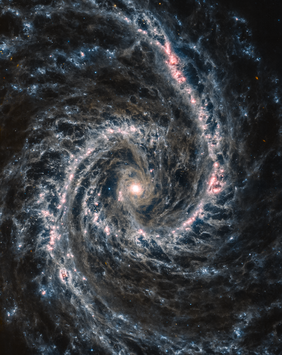I found another version of the JWST portrait of M66, processed by another person. And as long as everything we see is infrared light, we can map it to whatever visible colors we want to, right?
The dust that is highlighted by the JWST image is the raw material for star formation in M66. The dust is also the "stabilizer" for the spiral shape of M66 in the first place. It is possible to find "fossil" all-yellow apparently dust-free galaxies with a weak spiral structure, but the way I understand it, well-ordered "spiral dust structures" is what "upholds the spiral-ness of spiral galaxies".
Anyway, the Leo Triplet. I found a picture that I really liked, but it is an AAPOD2 image, and I'm not absolutely sure it is safe to open links to them. Is it, bystander? Well, I uploaded the image to my computer, and here it is, perfectly harmless:
Leo Triplet. Credit: Boris Vladimirovich
In Boris Vladimirovich's image, M66 is at top left, M65 is at bottom and NGC 3628 is at top right. I'm not sure that M66 is the largest of the galaxies in the Leo Triplet, because NGC 3628 looks bigger to me.
Note that the dust lanes of M66 are red from hydrogen alpha in Boris Vladimirovich's image, and we can also see a few young blue star clusters. There is certainly star formation going on in this galaxy. If you want some technical information on how Boris Vladimirovich acquired his image, it is
here (the AAPOD2 link).
By contrast, the other two galaxies of the Leo Triplet lack red nebulas and obvious blue star clusters.
NGC 3628 has a fantastic long tail:
Interestingly, NGC 3628 is very slightly similar to those jellyfish galaxies that fall through the intergalactic medium of a large galaxy cluster and are compressed on one side and lose their gas on the other side:
Interestingly, NGC 3628 seems to be flying
away from the other two galaxies, And that is indeed possible: It may have received a "tidal kick" that made it fly away in this direction. But it is sure to come back!
Because the galaxies of the Leo Triplet are indeed interacting. That is why NGC 3628 looks so squished and puffed up at the same time, and that is why M66 is somewhat asymmetrically shaped and why it is forming quite a lot of stars. And that may just possibly be why sedate M65, that looks fit for an old galaxies' retirement home, suddenly blew a core collapse supernova back in 2013.

The world, and certainly the Universe, is full of surprises!
Ann
 Unusual Spiral Galaxy M66 from Webb
Unusual Spiral Galaxy M66 from Webb












